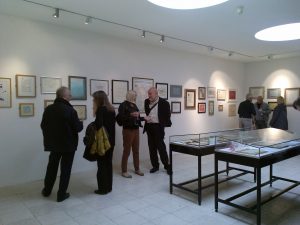Battling to save Bede’s World
One of my favourite places to visit unexpectedly closed last week.
Bede’s World, a museum celebrating the life and times of The Venerable Bede, shut its doors on Friday, with the board of trustees blaming financial pressures (read the full statement here).
As I flicked through some old blogs, I realised what an impact the place has had on my business, as well as being one of our regular haunts as a family.
Jarrow Hall, which was the original home of the museum before it expanded into neighbouring premises, was the venue for meetings of the South Tyneside branch of the Inspire Network.
The networking group for women, of which I am a member, is now looking for a new meeting place, as are the Northumbrian Scribes, a group of calligraphers who met at Bede’s World once a month.
I know many of the scribes through the calligraphy class I attend, which is run by its chairman, Susan Moor, and I have had the pleasure of attending their last two annual exhibitions there (A Love of Letters in 2014 and Handwritten in 2015).
It is less than two years since Bede’s World welcomed the Codex Amiatinus for its first trip outside of Italy, where it is currently held, in Florence. Bede is believed to have helped write it in 7th century Northumbria, at the twin monasteries of Monkwearmouth-Jarrow.
Chatting to the then director of the museum, Mike Benson, about the Codex, led to an invitation for me to hold calligraphy workshops at the museum, as well as give a talk about calligraphy as part of their summer salons.
I was also invited to be part of a medieval festival at the museum, to demonstrate my skills to visitors.
A similar chance meeting, with artist Mark Gibson in the reception of Bede’s World, led to my involvement in a public art project that I still take great pride in.
Mark, whose studio has also been affected by the closure of the museum, was looking for a calligrapher to collaborate with on a community art project he was pitching to Metro bosses.
The resulting piece, entitled Convergence, featured my calligraphy on several decorated panels at Bede Metro station in Jarrow, with poems by local writer Tom Kelly and a passage from Bede’s Ecclesiastical History of the English People, his best-known work.
Written in the 8th century, it is a history of the Christian churches in England and of England generally.
Originally composed in Latin, it is considered to be one of the most important original references on Anglo-Saxon history and has played a key role in the development of an English national identity.
It also led to Bede gaining the title of ‘The Father of English History’.
His importance has led to the launch of a campaign to save the museum, which I hope will succeed.
It has already garnered the support of big names, including writer and broadcaster Lord Melvyn Bragg, former Newcastle City Council leader Lord Jeremy Beecham and musician Billy Bragg.
A Facebook group has been launched for supporters of the campaign (you can find it here) and a petition is also up and running on the change.org website here. You can also pledge your financial support via Crowdfunder here.












Fantastic post, it really highlights the importance of the venue within the local community, reminding us all that it has never been *just* a museum.
Such a shame. We had some good times here when my daughter was little.
What a great blog & so well written! Says so much about this place that is important not only to us locally & our north east culture & heritage but to the whole nation. Hope this is read by folk who may need to understand this!